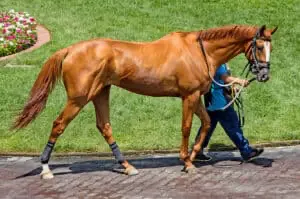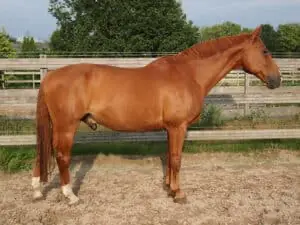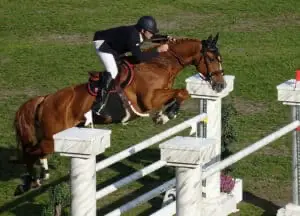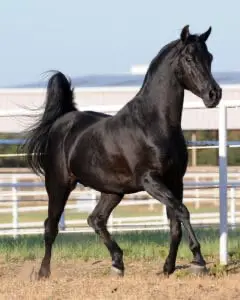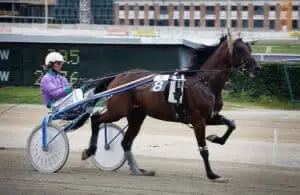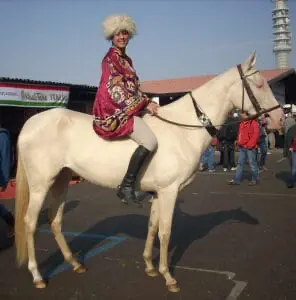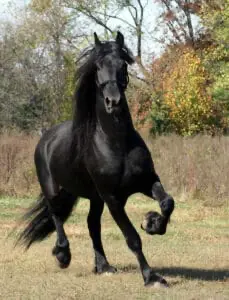We all know that owning horses can be an expensive business, with the yearly costs running into the thousands, and that doesn’t include the cost of buying the horse. Of course, the cost of buying a horse can vary wildly with people paying no more than a few dollars (or even in some cases only a few cents) to literally paying millions of dollars. But with the prices being so different, even within the same breed, it started me thinking what are the most expensive breeds and why are they so expensive?
What determines the value of a horse? Let’s be honest, regardless of whether we’re after a field mate for a long-retired favorite horse or a top-quality mount to compete on at weekends we’re willing to pay a lot of money for the right horse. This is one of the reasons why horses are often associated with an opulent lifestyle and when you consider that some horses sell for millions it’s easy to see why this is the case.
Valuing a horse isn’t an exact science and while many factors are taken into account (such as bloodlines, competition performance, training, etc) there’s still a certain amount of luck. Snaafi Dancer, for example, was the first yearling to sell for more than $10 million, yet despite his impressive pedigree (being the son of the famous Northern Dancer) he never raced and was said to be ‘embarrassingly slow’. That said though there are some breeds that routinely command prices that are far higher than the average home.
Thoroughbred
Height: The average is 16hh (64 inches) but anything between 15.2hh (62 inches) and 17hh (68 inches) is allowed.
Color: Bay, brown, chestnut, black, and grey are the most common but palomino and white can occasionally be found.
Country of Origin: England, UK
Typical price: You can buy an OTTB (off the track Thoroughbred, which means the horse has been registered with the Jockey Club but has either retired or never ran) for anywhere between $500 and $35,000.
Four out of the five most expensive horses ever sold were Thoroughbreds which is why the breed is, without doubt, the most valuable and expensive breed in the world, and when you consider it was originally bred as ‘the ultimate racing machine’ its easy to see why. With Sheikhs, Kings, and rock stars willing to pay hundreds of thousands of dollars (and even tens of millions in some cases) for horses with either a proven track record or promising pedigree.
Capable of running a mile at a steady 40mph (63kph) it’s no surprise that the Thoroughbred holds more racing world records than any other breed but it has also excelled in the dressage arena as well as in the jumping ring.
Most expensive Thoroughbred horses
- Frankel – While the unbeaten stallion hasn’t been sold he has been valued, for stud purposes, at over $100 million.
- Fusaichi Pegasus – The 2000 Kentucky Derby winner was recently sold for a record-breaking $70 million.
- Sharif Dancer – Sired by Northern Dancer, the 1983 UK Middle Distance Horse of the Year was sold for an incredible $40 million.
Dutch Warmblood
Height: There’s no upper limit but mares must be at least 15.2hh (62 inches) while stallions must be taller than 15.3hh (63 inches). Most horses will typically stand at around 16hh (64 inches)
Color: Any solid color is allowed but chestnut, gray, bay, black, and brown are the most common.
Country of Origin: The Netherlands
Typical price: Depending on age, pedigree, and training you can buy a Dutch Warmblood from anything between $5,000 and $25,000.
A relatively new breed (its studbook was started in 1958), the Dutch Warmblood is an outstanding, world-class competition horse that is regularly ranked as one of the top three most successful breeds by the World Breeding Federation for Sports Horses (WBFSH). With this sort of accolade, it’s easy to see why the Dutch Warmblood is one of the most expensive breeds, outside of Thoroughbred racing, in the world. Not bad for a horse that was once used as a draft breed for agricultural purposes.
Today the Dutch Warmblood is a much lighter horse that still has the power and stamina of its ancestors.
Most expensive Dutch Warmblood horses
- Moorland’s Totilas – Also known as Toto, this Dutch Warmblood was said to be the best dressage horse ever, he was the first dressage horse to score 90, and was sold back in 2010 for around $15 million.
- Marius Silver – Better known as Milton, this Dutch Warmblood x Irish Draught was the first horse outside of the racing world to win over £1 million (Approx. $1.28 million) in prize money.
Selle Français
Height: Normally anything between 15.1hh (61 inches) and 17hh (68 inches).
Color: While chestnut is the most common (and popular), any color is allowed.
Country of Origin: France
Typical price: The price can vary a lot depending on how well trained the horse is, its age, pedigree, and previous competition record, but typically you can expect to pay anything between $2,000 and $40,000 for a well-trained, experienced horse.
You might be surprised to see the Selle Français (or French Saddle Horse as its also known) in a list of most expensive horses but they are often overlooked in terms of their ability, after all the WBFSH last year ranked them in 5th place for showjumping which is one of the reasons why they can command such a high price.
The Selle Français has a bit of a mixed history, descending from heavy draft horses that had been crossed with German, Arabian, and Thoroughbred horses, the breed has evolved into a classic sports horse that is famed for its strength, athleticism, and intelligence, not to mention its plentiful jumping scope.
Most expensive Selle Français horse
- Palloubet d’Halong – It’s not known exactly how much this top showjumper sold for but its thought to be in the region of $15 million to $20 million.
Arabian
Height: Most Arabians will stand at around 14.3hh (57 inches) but they can be as tall as 16hh (64 inches).
Color: Black, brown, chestnut, and gray are the most common but any solid color is allowed.
Country of Origin: Arabian peninsula
Typical price: The Arabian probably has one of the widest ranges when it comes to price, while you can buy a registered horse (with papers) for around $2,000 you can also spend close to $160,000 for a well-trained horse with a good lineage.
As well as being one of the oldest breeds in the world, the Arabian is also one of the most beautiful and elegant horses you’ll find which is part of the reason why people are willing to pay so much money for them. Believed to have descended from the war horses bred by the Prophet Mohammad, some bloodlines go back hundreds, if not thousands of years. Often described as the ideal horse, the Arabian of today hasn’t changed much from those of old – after all, you can’t improve upon perfection!
As well as being an ancient breed, the Arabian is also valued for its beauty, speed, stamina, and hardiness which is one of the reasons why it has been used in the development of so many other breeds (such as the Thoroughbred) around the world.
Most expensive Arabian horses
- *Padron – Sold in 1983 for an estimated $11 million, this Dutch bred stallion is the most expensive Arabian horse ever sold. While $11 million may not sound like a huge amount, especially when compared to the price paid for some breeds, but in today’s money, it’s actually just under $30 million.
- Pepita – Sold during the famous Pride of Poland Arabian Horse auction in 2015, the 2014 National Champion sold for just under $2 million.
American Standardbred
Height: American Standardbreds can stand anywhere between 14hh (56 inches) and 17hh (68 inches) but most will range from 15hh (60 inches) to (64 inches).
Color: Any color is allowed but black or any shade of brown (ie brown, bay, or chestnut) are the most common.
Country of Origin: USA
Typical price: The price of American Standardbreds can vary but, depending on age, training, and pedigree you can expect to pay somewhere between a few hundred dollars and $20,000.
The American Standardbred may not be the first breed you think of when asked to name the world’s most expensive horse breeds but, while they won’t command the sort of money Thoroughbreds do, they can (and have sold for millions).
Said to be the best trotting breed in the world, the American Standardbred, which can be traced back to the famous Messenger (a Thoroughbred once owned by Henry Astor) was developed solely to be a harness racing horse. Today there are two types of American Standardbred, the trotter that is used for harness racing, and the pacer which is regularly raced in saddle trot competitions.
Most expensive American Standardbred horse
- Maverick – This trotting horse was sold, as a yearling, in 2019 for $1.1 million. He went on to win his debut race with a lead of one a half lengths – a record for a maiden race.
Akhal Teké
Height: Most Akhal Tekés stand between 15hh (60 inches) and 16hh (64 inches), although their height can range from 14hh (56 inches) and 16hh (64 inches) is allowed.
Color: Any solid color can be found, often with a metallic sheen.
Country of Origin: Turkmenistan
Typical price: The starting price for a purebred Akhal Teké, with valid registration papers, can be around $100,000.
Said by some to have created the Arabian breed, the Akhal-Teké is not only one of the oldest breeds in the world but it’s also pretty rare (there are only around 8,000 purebreds in the world and many of those are in Turkmenistan and Russia) which is one of the reasons why it’s so expensive. These beautiful horses are known for the metallic sheen that their coat often has and are often said to be ‘one person horses’, due to their loyalty.
Ancient Chinese legend refers to the Akhal Teké as ‘heavenly horses’ and the people of Turkmenistan still hold them in high regard – being the national emblem of the country they can be found adorned on banknotes, stamps, and even on coats of arms.
Friesian
Height: They can stand anywhere from 14.2hh (58 inches) to 17hh (68 inches) although the average is around 15.3hh (63 inches). To be allowed to be classed as ’star’ (awarded to horses showing quality conformation) horses need to be at least 15.2hh (62 inches).
Color: Famous for their solid black coats, chestnut, and bay can also be found, albeit rarely. A white star is the only white marking allowed.
Country of Origin: Netherlands
Typical price: The starting price for a good Friesian is around $5,000 but you can expect to pay over $100,000 for a top-quality horse.
Thought to be one of Europe’s oldest domesticated breeds (with records showing the breed is at least 800 years old) the striking Friesian was almost extinct at one point, with only a single breeding pair left. These two horses were carefully bred in an attempt to save the breed and, with the help of Spanish (in particular the Andalusian) and German horses, they evolved from the heavy horse they once were to the lighter more elegant horse we have today.
The Friesian is a very distinctive breed that is famed, not only for its solid black coat but also for its long flowing mane and tail that are never cut and can often reach the floor. They also have an elegant, high-stepping gait that has made them a popular dressage and carriage horse as well as a stunning attraction in the circus ring.
Further reading
- Breeds perfectly suited to trail riding
- Best breeds for children
- Dotty about spotted breeds
- The fastest breeds in the world
- Best dressage breeds for all levels
- Perfect jumping breeds for all riders
- The best breeds for eventing
- Ideal breeds for new riders
- The best barrel racers in the world
- The worlds most unusual breeds
I hope you found this article helpful. If you did I’d be grateful if you could share it please as it would really help me.
Recommended products
Over the years I have tried hundreds of different horsey products, from various blankets and halters to different treats. Some I’ve loved, others I’ve hated but I thought I’d share with you my top all-time favorite products, the ones I never leave the yard without. I’ve included links to the products (which are in no particular order) that I really think are great.
- Horse Knots by Reference Ready – If you’re like me and enjoy pocket reference guides then you’ll love this knot tying guide. These handy cards can easily fit in your pocket or attach to the saddle for quick reference. They’re waterproof, durable and are color coded to make them easy to follow.
- Mane ’n Tail Detangler – Even if you never show your horse you’ll need to detangle his tail from time to time (and possibly his mane too) which is always a challenging chore! I’ve found that if I run a little bit of detangler through my horse’s tails every few days it stops them from getting matted up and makes combing them easy, even if they’re coated in mud. I don’t know if I should admit to this or not but it also works wonders on my hair.
- TAKEKIT Pro clippers – Over the years I’ve tried a lot of different clippers and while some were obviously better than others I found these to be by far the best. They are heavier than a lot of other clippers but for me, that’s a good thing, it makes them feel more sturdy and hardwearing. On top of that they have a range of speeds so are just as good for clipping your horse’s back as they are his face. I also like the fact that they come in a handy carry case but that’s not for everybody. The company that makes them is super good and incredibly helpful too, a real bonus these days. The only thing I wasn’t keen on was the fact that it doesn’t come with any oil, but that’s not a major problem as it’s not difficult to buy lubricant.
- Shire’s ball feeder – There are so many boredom buster toys out there but I like to use these every day, regardless of whether or not my horses are bored. I find that it helps to encourage my horses to problem solve by rewarding them with treats (or pieces of fruit) but it also mimics their natural grazing behavior which helps to keep them calm and de-stressed.
- Horse safe mirror – This is a strange one that many people are surprised about but I like to put horse safe mirrors in the trailers as well as in the quarantine stalls. It helps to prevent the feeling of isolation by giving the impression of other horses being around. Being herd animals horses can get extremely stressed when they feel that they’re on their own but with these stick-on mirrors, they believe that at least one other horse is with them.
- Rectal thermometer – I know this isn’t glamourous at all but it’s vital for your horse’s well-being to be able to check their temperature and a rectal thermometer is the easiest way of doing this which is why I’ve added it to the list.
Shopping lists
I’ve also put together a few shopping lists of essential items that I’ve found helpful over the years. I’ve broken the lists down into different categories rather than put everything in one massive list 😉

